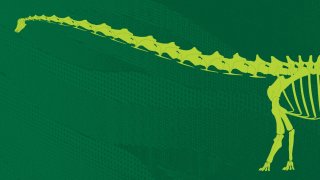
What to Know
- A sauropod skeleton measuring 75' long will debut this fall inside NHM Commons, the Natural History Museum's new wing
- Deposits of the mineral celadonite give the dinosaur, which was discovered in Utah in 2007, a green sheen
- The museum asked the public to vote on a new name earlier in June, providing five catchy contenders; Gnatalie was the winner
Dinosaurs were not natty — the ancient beasts were not known for their high style nor their ability to match shoes with belts with purses with hats — but sometimes, if the conditions are met, a dinosaur can be, well, quite gnatty.
As in, covered with gnats, the tiny insects that we all know and seem to duck, over and over again, at every barbecue or picnic we attend.
Paleontologists made a thrilling discovery in Utah around 17 years ago that was highly gnatty but also extremely notable: Fossils belonging to a sauropod. In fact, it was, in fact, "a new species of sauropod," at least a species scientists hadn't seen before.
Get top local stories in Southern California delivered to you every morning. Sign up for NBC LA's News Headlines newsletter.
Gnats were plentiful at the dig site, and so the dino pros began referring to the sauropod by a catchy name: Gnatalie.
Never let it be said that paleontologists are not a deeply playful bunch; after all, they're the ultimate dinosaur super-fans, in a world where pretty much everyone is obsessed with the sizable superstars of the Jurassic.
The gnat-tastic nickname stuck, and it turned out be a name that no one wanted to swat away.
The Scene
Want to find new things to do in Los Angeles? The Scene's lifestyle stories have you covered. Here's your go-to source on where the fun is across SoCal and for the weekend.
When the Natural History Museum, which will serve as the sauropod's new and forever home beginning in fall 2024, asked the public to help select a name for the fabulous find, Gnatalie had the buzz: It won out over four other names.
Those names were all inspired by the color green, for Gnatalie is green, or greenish, thanks to celadonite, a mineral that is amply deposited throughout the fossil find.
Were we burying the lede on the whole "this dinosaur is green" part? Well, given that Gnatalie was buried for millions of years, you'll forgive us for getting around to that fantastical fact eventually.
Over 8,000 votes poured in, with about a third of voters choosing Gnatalie.
The Natural History Museum made the announcement on June 25, and gnat a moment too soon: Dino devotees are stoked about Southern California's newest resident.
Because the truth is this: Everyone around Los Angeles always wants to know the names of the fresh up-and-comers, those young notables set to make local and potentially worldwide headlines.
With that in mind, meet SoCal's next star: It's Gnatalie, who, at several million years old, is not young and may be described as both notable and, well, gnatable.
Formerly gnatable, that is; Gnatalie is leaving the gnats of the past behind for a brighter future inside the new NHM Commons this fall.



